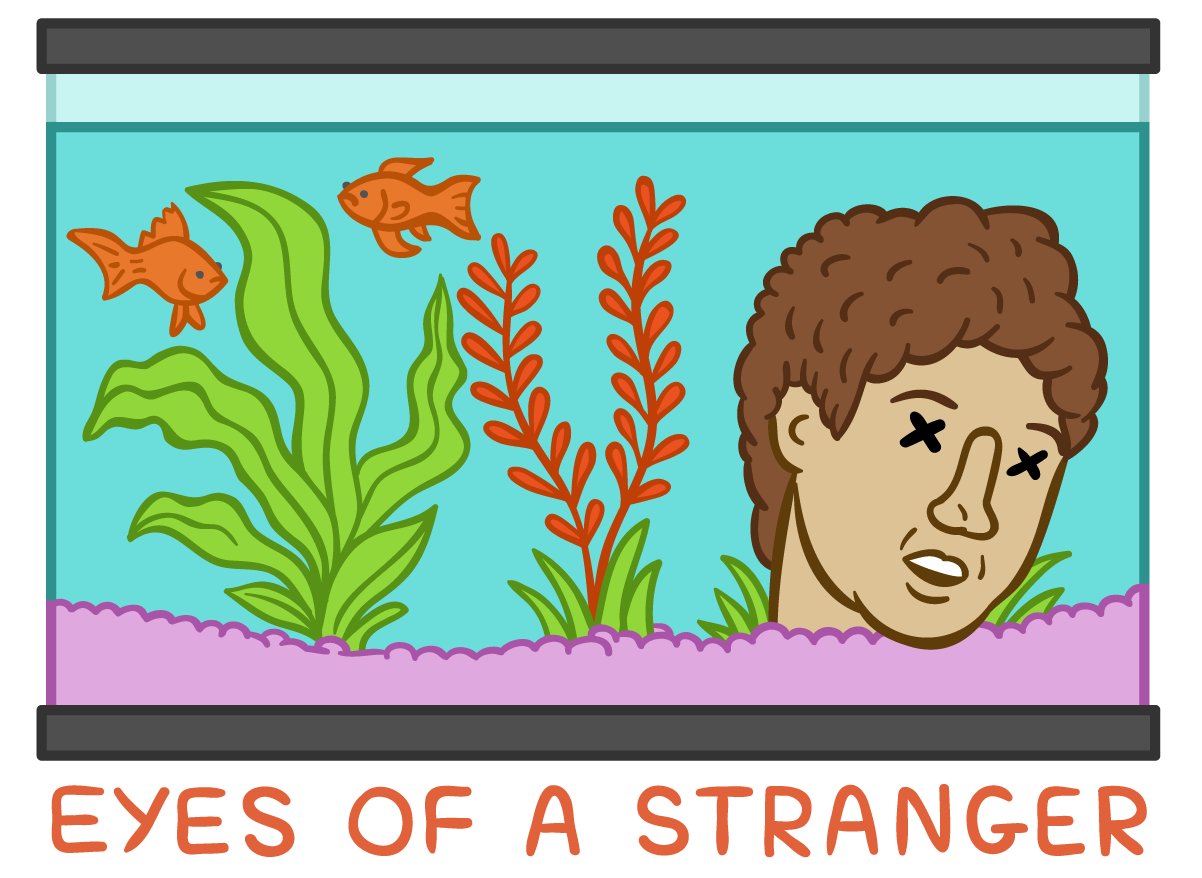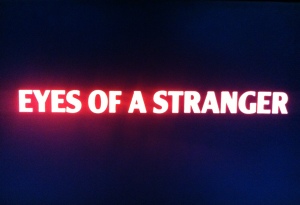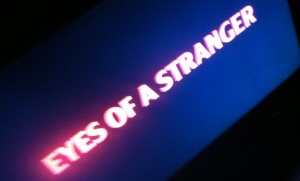The October Diaries: Eyes of a Stranger
 Â
Illustration by Max Brown
Blurbs by Erin Roycroft, Sean & Christof
Â
Illustration by Max Brown
Blurbs by Erin Roycroft, Sean & Christof—
October 25th, 2014:
Eyes of a Stranger
Year: 1981
Director: Ken Wiederhorn
Format:Â DVD
From IMDB: A reporter suspects a creepy neighbor, who lives in the high-rise building across from hers, is a serial killer terrorizing the Miami area.
Erin Roycroft’s Take:
I don’t know what kind of karma I must have worked up to deserve this, but the second (and last) horror film I watched with the Whitemans last October was also about a terrorized blind woman –and also pissed off my feminist sensibilities. Unlike Wait Until Dark, Eyes of a Stranger was not a good movie. Let’s just get that out of the way. It’s a predictable 80’s slasher/thriller about a serial rapist and murderer, full of feathered hair, bad acting, and gratuitous boob shots of thin, blonde Hollywood actresses. The first boob shot is in the opening credits, and you should take this as a clue for how the rest of the movie is going to go.
The first five minutes are about as cliché as it gets. We follow Debbie, a typical blonde female sex object, on her late-night walk home from the strip club where she works (because, duh, sex object). She leaves work. She’s on foot. It’s late. A man’s footsteps follow her on the dark sidewalk. As a single lady who sometimes stays out late and comes home alone, this is what my nightmares are made of. It’s a real thing that happens, but in a horror film, it’s also horribly overdone.
Debbie gets into her apartment unharmed, but soon she starts getting creepy phone calls from a man telling her he is going to fuck her and kill her. Cut to a phone booth where a man stands in the shadows putting coins in the slot, and we have our perp. A psycho pervert in the shadows whose face you cannot see is infinitely creepier than one whose face you can. I am so vulnerable to this kind of tension, which is probably why I never watch horror movies (unless it’s October at the Whitemans’). I know it’s bad writing. I know it’s tired tropes. And still I get so stressed out.
Somehow, through all of my eye-rolling, shots of scantily-clad, braless Debbie – nipples poking out at every turn – grabbing a knife and tiptoeing around her apartment in search of the perv made me so nervous that I developed a massive case of heartburn, which stuck with me through the entire movie.
Spoiler alert: Things don’t end well for Debbie. The perv tackles her, rips open her shirt and exposes her breasts (because duh, boobs), straddles her and slaps her around before taking off his belt and putting it around her neck. Presumably he rapes her and murders, though, mercifully, this violence is not shown on screen. In the next scene, a news reporter talks to the camera about her death.
All of that in the first five minutes.
Here is a mini-rant, which you are free to skip: Had I been watching Eyes of a Stranger by myself, I would have turned it off here – or maybe even sooner – because I am over watching over-the-top scenes of women get raped and/or murdered on screen. There is a sick kind of voyeurism that this gratuitous violence against women appeals to. When women are brutalized in this way, especially female characters whose sole function in the film is as one-dimensional sex objects not to be taken seriously as people, their victimization gets turned into a spectacle not to be taken seriously. I’m just over it.
Because I was at the Whitemans’, and because it was October, I didn’t walk out. I persisted through the next eighty or so minutes. Thankfully, the movie takes a slightly different tone once we find our heroine.
The rest of the story follows the news reporter-turned-sleuth, Jane Harris, who is intent to prove that her neighbor is the perp. There are a few sub-plots: Jane has a boyfriend who won’t take her seriously about her suspicions; Jane lives with her younger sister, Tracey, who is blind and deaf; Tracey, we find out through clumsy flashbacks, became inexplicably blind and deaf after she was abducted, presumably by a child molester, when she was a child. Jane, also a child at the time, hadn’t been watching her closely enough. It’s all Jane’s fault; she must atone for her sins. I’m pretty sure we are to believe this is why Jane is so motivated to find the rapist/killer.
There is a delightful role reversal moment when Jane, having found his address and phone number, turns the table on the phone-booth serial rapist pervert and starts calling him and harassing him. She fucks with him over the phone. She breaks into his house while he’s out. Unfortunately, he also finds her address, and while Jane is in his apartment, he’s over in hers, trying to murder poor, blind, deaf, and defenseless Tracey.
Before Jane can make it back to her apartment to rescue Tracey, who has been struggling against the creep for an agonizingly long time, it turns out Tracey has more brass than anyone has given her credit for. In the act of defending herself, Tracey starts to regain her sight, her hearing, and her speech. Oof. The symbolism isn’t just heavy-handed, it’s a straight-up slap in the face. Eye rolling abounds. Though there is a deliciously bad moment when Tracey, whose shirt has been ripped open to expose her breasts (because duh, boobs) looks at herself in the mirror for the first time and traces one bloody finger down her chest.
The moral of all this? Don’t watch this movie. It’s not worth it. I’ve already spent more time on it than it deserves.

Christof’s Take:
Who’d’a thunk we would watch not one, but two blind-centric psychological slashers this month. To accidentally bookend Wait Until Dark, we chanced upon Eyes of a Stranger — a title that ends up having some literary potency, which is nice, but I wouldn’t necessarily say an explored appreciation of that phrase would be enough of a reason to watch this one. The irony in the title may be deeper than the irony within the story to which it points.
Comparing it “in-houseâ€, as far as the month is concerned, Eyes of a Stranger is a mix between Wait Until Dark and Someone’s Watching Me! And while it was tense and engaging, it wasn’t as satisfying as either.
It is another high-rise horror, featuring another demented and misogynistic serial creep, and it is also another “psychological slasher†that involves the torment of another disabled woman — Jennifer Jason Leigh’s character is one that has upped the ante on Audrey Hepburn’s portrayal of Susy Hendrix, in the sense that she has fewer senses — deaf, dumb, and blind. While Leigh is impressive in her debut, I’m not sure anyone can truly up the ante on Hepburn’s performance in Wait Until Dark. (Tip: Go watch that instead.)
There is perhaps some good to be found in this movie, but it suffers from a lack of unified vision, taking its life-scenes more seriously than its death-scenes — which is to say that it seemed to pull off some — if few — respectable moments during the non-horror segments, and then the production aesthetic seemed to toggle into generic slasher movie mode when the genre announced itself. And this turns out to make sense, because — if IMDB’s trivia section is credible — halfway through production of a more “straight-forward thrillerâ€, they “decided to embrace the then-current slasher genre and introduce more gore and violence.†And unnecessary and uncomfortable nudity.
I know, I know. This is common pitfall of the genre. What do you expect, ya numbskull? I don’t know what I expect, but the part of me that doesn’t necessarily mind unnecessary nudity showing up unannounced only wants to see such a thing in the context of someone undressing by choice. I despise the notion and cliché of the pre-kill shirt-rip. Seeing nudity in the context of rape and murder, especially in scenes that feel produced with the spirit of a popcorn flick makes me very uncomfortable. It always has. If it felt like a specific and meaningful design of intent was to make me feel uncomfortable, I would be more comfortable with the discomfort. Unfortunately, the scenes did nothing to lead me to such a conclusion. They felt simultaneously cheap and expensive, which ultimately made them feel disrespectful.
I do remember the creep being suitably creepy. Months after the fact, one of the only notes I took down that jogged my memory was, “Fondles his hallways.†Reading that dropped a few images in my head. I believe the character is given a scare that challenges his autonomy — or maybe he’s just creepin’ pro-bono around his home — but I think he drags and fondles his fingers along the walls of his hallway to calm himself down. A wonderful detail amidst a mess. Unless I’m mistaking this with another movie this month, I want to say the actor playing the stalker-rapist-murderer was doing a fairly good job of appearing both scary and unstable. And I’ll also say Lauren Tewes carried the movie well as our lead, Jane Harris, a TV anchor/reporter who is trying to investigate a suspect neighbor while putting herself and her disabled sister, Tracy, in danger.
There’s a lot more to be said about this one, I’m sure, but that would require me to watch it again, and I’m not so sure that’s ever going to happen. I do believe that the DVD we watched was an “Unrated†version, so perhaps if you still want to watch it, consider watching the R-Rated Theatrical Release — it may have a tinge more of respectability.

Sean’s Take:
With only a few more titles to go until the end of the October odyssey, a few thematic trends have started to emerge.
We have (thus far):
- Haunted Families (Something Evil, The Conjuring, Insidious)
- Sororities Stalked By Escaped Inmates With Familial Ties (Sorority House Massacre, The Initiation)
With Eyes of a Stranger, we have supporting material for:
- Peeping-tom-creepos (Hardware, Someone’s Watching Me!, Eyes of a Stranger)
And the mini-trend of:
- Blind-woman-terrorized (Wait Until Dark, Eyes of a Stranger)
I’m sure there are more thematic currents from October that I’m missing, but the rarity of two horror films featuring visually impaired protagonists felt uniquely rare to stumble across. Audrey Hepburn carried the load in Wait Until Dark and Jennifer Jason Leigh, in her first major feature film role, fought the darkness in Eyes of a Stranger. Both films played with this scenario in a way that would’ve made Hitchcock proud, albeit Wait Until Dark alone had the class to match the fear.
Unfortunately, Eyes of a Stranger chose sexual terror as its method of unsettling viewers. While I indulge in the laughing-at-the-void comedy at play with all good cinematic death scenes, I do not feel the same type of cathartic joy when a villain molests and rapes before murdering. It sounds almost hypocritical to enjoy only a certain kind of death depiction, but there are many different kinds of cringes to indulge in and this isn’t a terror to wallow in and giggle at.
I don’t have fascinating thoughts on this one, but it didn’t feel like one to be fascinated with. It was grim bit of ugly that survived as well as it did on the basis of a few unique scenarios. The highlight of the movie (or at least most memorable moment) was when Leigh regains her vision, after losing it in a trauma years before, and she finally gets to see what she looks like as a grown up woman, having not had vision since she was traumatized as a child. Leigh sells the scene with a dramatic weight that the movie struggled to shoulder.
As is often the case, the best thing to come out of watching this movie was getting Max’s illustration.